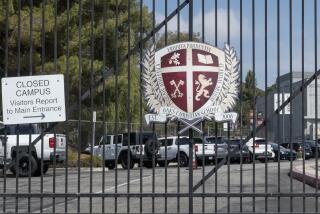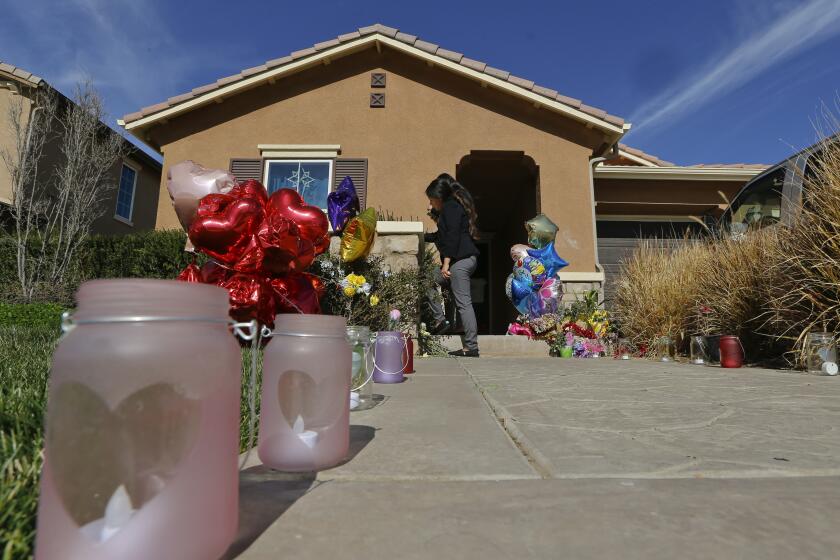Window to the Past
Spring water, protective mountains and an ample number of local Indians to convert drew Franciscan priests to the rugged site where they founded Mission San Fernando, Rey de Espana, named for Ferdinand III, a saint and king of Spain.
Today, 200 years later, it is the mission’s historical treasures, carefully restored chapel and tranquil gardens that attract thousands each year for tours, study, weddings, baptisms and funerals.
The in what is today Mission Hills, was the 17th of 21 missions built by the friars near the California coast. The first nine were founded by Father Junipero Serra, while the lesser-known Father Fermin Francisco de Lasuen built the last eight, including the San Fernando Mission.
Although the exact number of Native Americans who passed through its thick adobe walls is unknown, mission records show that nearly 2,500 were buried in its cemetery.
Visiting the Mission
Open 9 a.m. to 4:30 p.m. daily, excluding Christmas and Thanksgiving; $4 adults, $3 seniors and children ages 7-15, children under 7 free.
Mission San Fernando
1 .Cemetery: Final resting place for nearly 2,500 Native Americans between 1798 and 1852. No headstones or markers. Some Spaniards and others also buried here, including priests. Cemetery continued to serve area Catholics until 1917.
2. Old Mission Church: A replica of the original church constructed from 1804 to 1806, with 7-foot thick walls at base, tapering to 5 feet at top. From 1797 to 1846, site of 3,188 baptisms, 2,449 burials and 842 marriages performed.
3. Workshops: Displays include a loom, period saddles, pottery and leather, carpenter and blacksmith shops, which include some original tools.
4. Archival Center: Opened in 1980 to collect, preserve, study and interpret documents, diaries, manuscripts, photographs and other written materials related to Catholic history of the Archdiocese of Los Angeles. Tours given 1 to 3 p.m. Mondays and Thursdays.
5. Museum: Items include original mission floor tile from 1803; original mission plates, cups and pitchers; handmade iron hardware, display on Native Americans, miniature mission bells collection and vestment worn by Pope John Paul II during 1987 visit.
6. Convento: Completed in 1822 after 12 years of construction, this is the only remaining structure from the original San Fernando Mission and the largest original mission building in California. Mission priests lived here, and during the mission era it was used as an inn for travelers.
Other features of Convento:
* 243 feet long, 50 feet wide, 4-foot-thick adobe walls, original iron grills.
* The large hand-hewn double doors of La Sala or Reception Room’s were mission’s main entrance. Shell patterns above door are an ancient motif. Hand-forged lock and bolt on doors and iron grating on windows are original. Original stenciling above rear door denotes grape harvest.
* A Wells Fargo wagon recalls its use from 1857-61 as a station for the Butterfield Stage Line between Los Angeles and San Francisco.
* Library has 1,760 books dating from the 1500s to the 1800s, on theology, medicine and geography.
* Bishop’s room: California’s first bishop, Diego Garcia, lived here from 1820-35
* Padre Lasuen Room: Reproduction of typical monk’s quarters includes desk, trunk, chairs and wooden bed.
* Possibly a prison originally, the Madonna Room now holds several hundred statues, plaques and paintings of the Madonna, including one dedicated to the Los Angeles Dodgers.
* Floral embellishments stenciled on walls were a popular decorative motif used in several missions.
Sources: San Fernando Mission; Msgr. Francis J. Weber; “Mission San Fernando Rey de Espana,” by May Null Boule; “The California Missions,” Sunset Books; “The Missions of California,” Chronicle Books
Researched by JULIE SHEER and STEPHANIE STASSEL / Los Angeles Times
More to Read
Sign up for Essential California
The most important California stories and recommendations in your inbox every morning.
You may occasionally receive promotional content from the Los Angeles Times.










